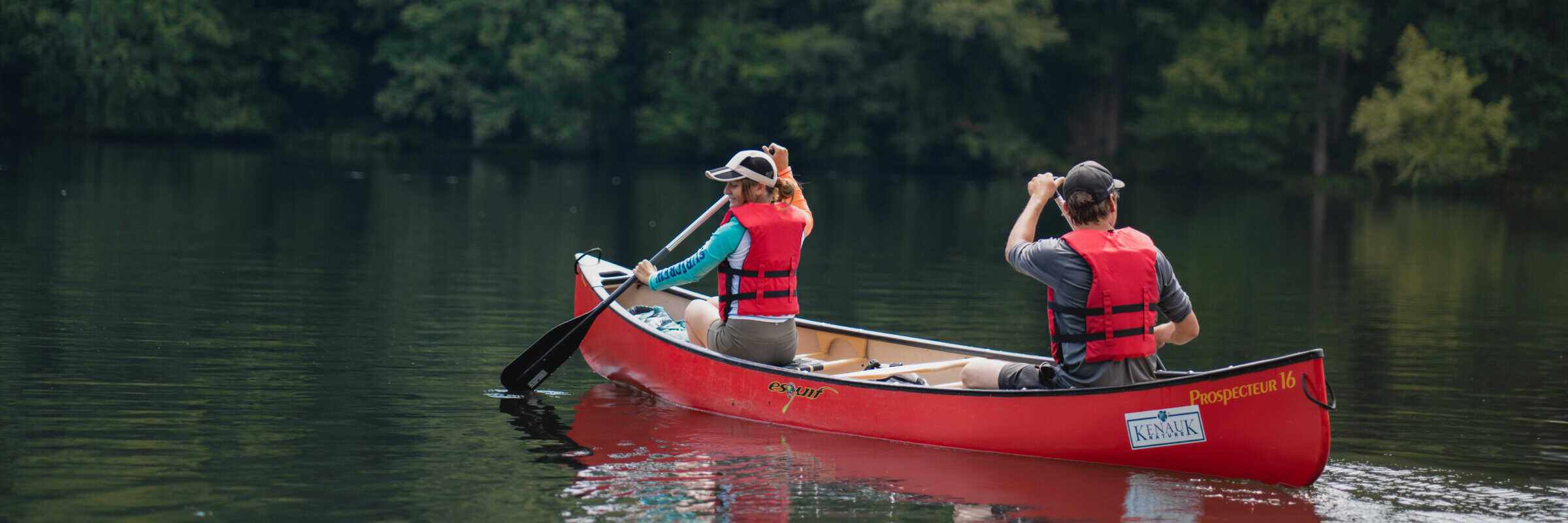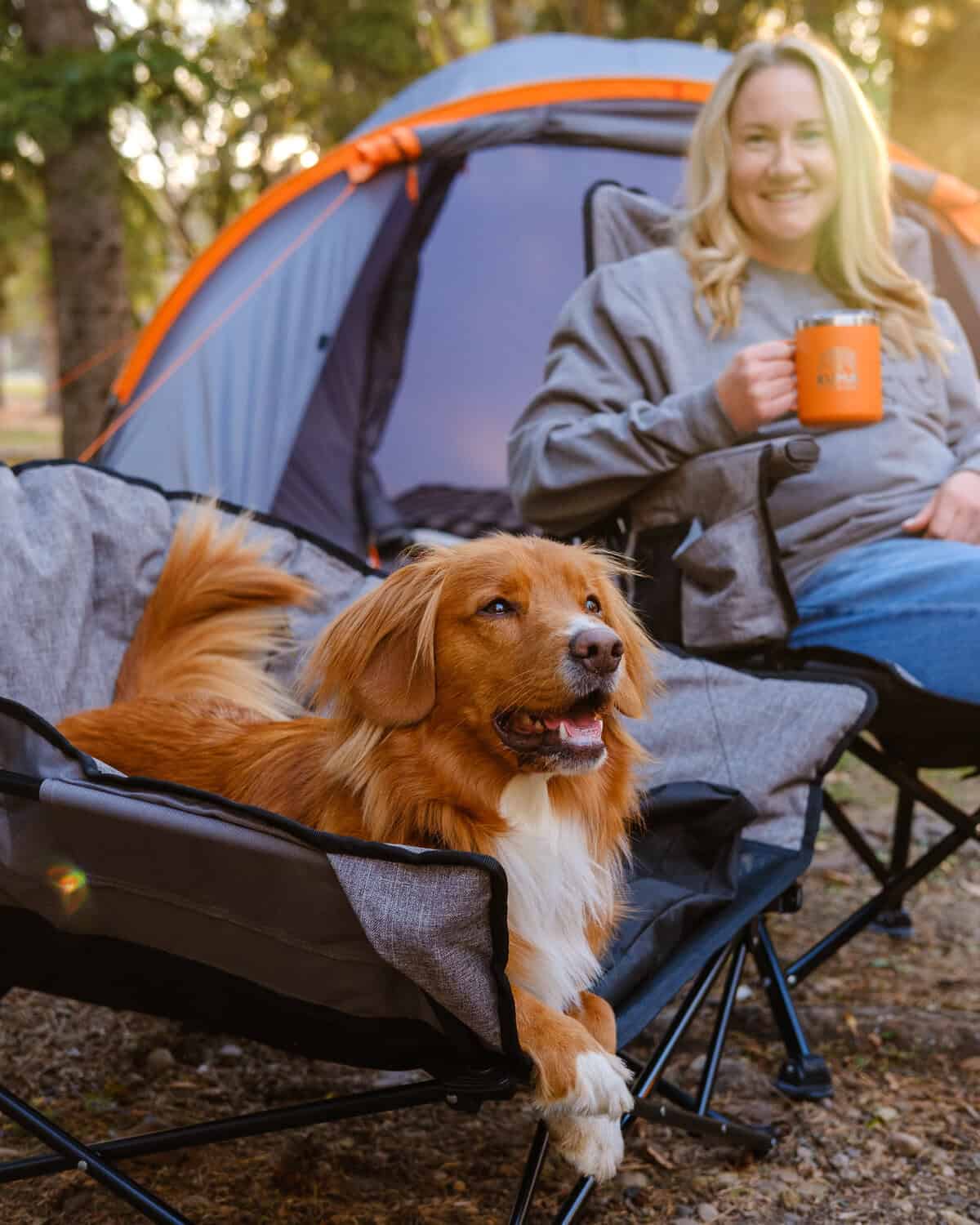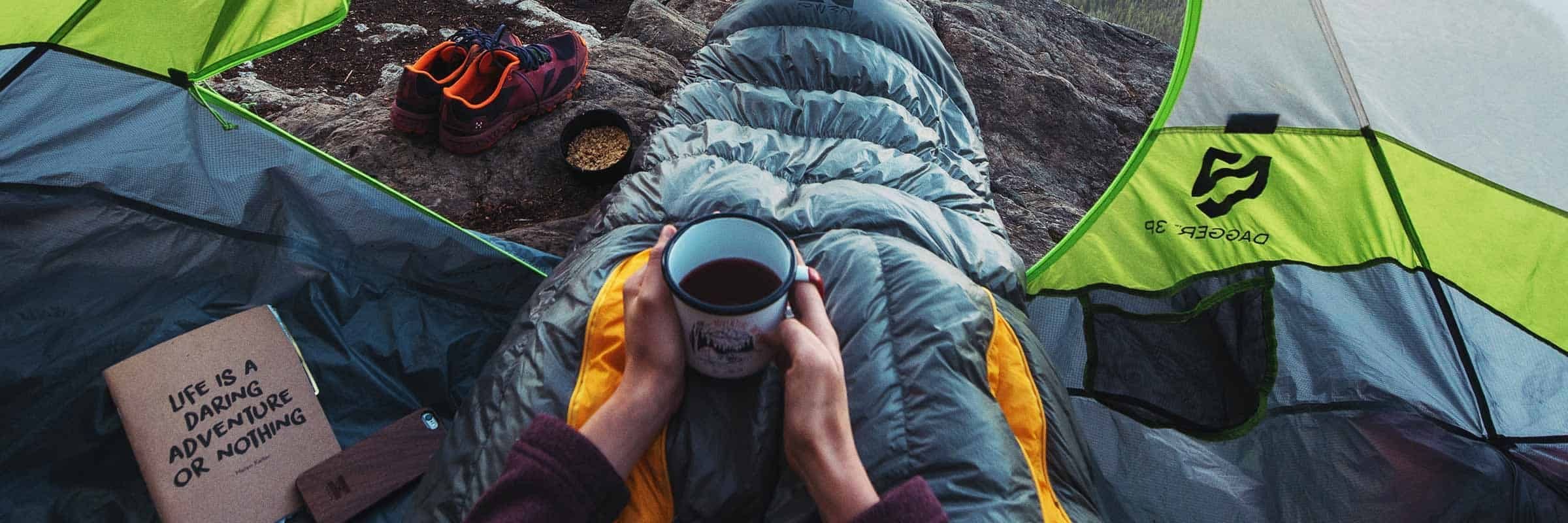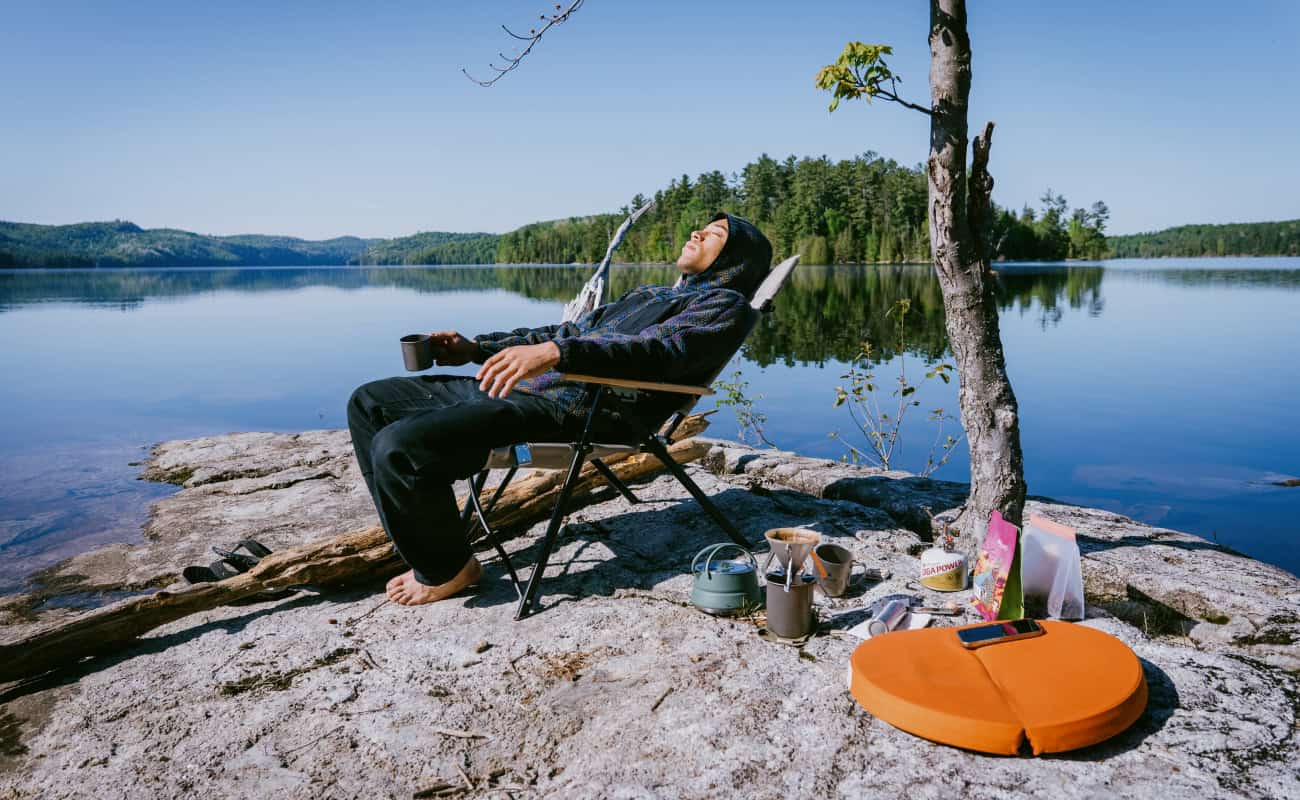A good night’s sleep in the backcountry starts with the right foundation—your sleeping pad. Whether you’re car camping in the Laurentians or trekking deep into Gaspésie, your sleep setup can dramatically affect your comfort, energy levels, and even safety.
The challenge? There’s no one-size-fits-all solution. Some sleeping pad are thick and plush but weigh a ton. Others pack down to the size of a water bottle but feel like you’re sleeping on a granola bar.
In this guide, we’ll walk you through the key factors to consider—like weight, insulation, R-value, and packability—and compare mattress types so you can choose the right one for your sleep style, trip length, and climate. From ultralight thru-hikers to comfort-first campers, we’ve got a sleeping pad pick for every kind of sleeper.
Table of Contents
What to Consider When Choosing a Camping Mattress
Choosing a sleeping pad isn’t just about grabbing the first pad you see on sale. Your ideal sleep setup depends on how, where, and when you camp. From backpacking to basecamping, side-sleepers to stomach-sinkers, your needs will vary. Below are the key factors to consider before making your pick.
1. Sleeping Style & Comfort
Not all bodies sleep the same. Side sleepers tend to benefit from thicker pads that cushion pressure points like hips and shoulders—look for sleeping pads with extra depth or plush materials (think the Sea to Summit Ether Light XT Insulated).
Back or stomach sleepers may be fine with thinner or firmer pads. If you’re used to a real mattress at home, consider a deluxe self-inflating model like the Therm-a-Rest MondoKing 3D.
2. Insulation & R-Value
A higher R-value means better insulation from cold ground and an easier time staying warm. For summer or warm-weather trips, an R-value of 1–3 should suffice. For shoulder seasons or high altitudes, aim for 3–5. Winter campers should look for 5+ (like the Therm-a-Rest NeoAir XTherm at 7.3). Even in summer, some insulation helps avoid heat loss overnight.
3. Weight & Packability
Backpackers and minimalist trekkers need lightweight, compact gear. Foam pads like the NEMO Switchback Insulated or inflatable ultralights like Therm-a-Rest Z-Lite SOL offer excellent packability. Car campers, on the other hand, can afford to go bigger and cushier.
4. Durability & Materials
If you’re using your sleeping pad often—or on rough terrain—go for one made of tougher fabrics. Self-inflating mats and closed-cell foam options typically win in durability, while ultralight air mats require a bit more care (though patch kits are often included).
5. Ease of Use
At the end of a long hike, no one wants to spend 20 minutes inflating a mattress. Look for pads with efficient inflation systems—like dual-valve setups or included pumps (Sea to Summit Comfort Deluxe SI or Big Agnes Rapide SL Insulated). Closed-cell foam pads require zero setup, while self-inflating pads offer a middle ground.
Camping Mattress Comparison Table
Consideration | Car Camping | Backpacking | Winter Camping | Minimalist / Fastpacking |
Comfort | Prioritize plush, thick mats | Balance comfort with weight and packability | Look for high insulation and moderate comfort | Minimal padding; comfort is secondary |
Weight | Not a concern | Critical—aim for ultralight models | Accept heavier weight for insulation | Ultralight is essential to save weight |
Packed Size | Doesn’t matter much | Must be compact enough to fit in a pack | Slightly bulkier okay if performance is high | Extremely small pack size preferred |
Insulation (R-Value) | Low to moderate (R 1–3) | R 2–4 for 3-season use | R 4+ or higher for cold ground | R 1–2; not ideal for cold temps |
Ease of Use | Self-inflating or thick air pads | Fast inflation + durability | Efficient setup in gloves or cold weather | Simple roll-up or Z-fold pads |
Recommended Products | Sea to Summit Comfort Deluxe SI Therm-a-Rest MondoKing 3D | Therm-a-Rest NeoAir XTherm Big Agnes Rapide SL Insulated | NEMO All-season Tensor Pad Sea to Summit Ether Light XR Insulated | NEMO Switchback Insulated Therm-a-Rest Z-Lite |
Types of Camping Mattresses
Not all camping mats are built alike—and that’s a good thing. Whether you’re car camping in comfort or fastpacking in alpine terrain, the right type of sleeping pad can mean the difference between restless tossing and restorative sleep. Below, we break down the three main types of sleeping pads: closed-cell foam pads, self-inflating mattresses, and air mattresses.
Closed-Cell Foam Pads
Best for: Minimalists, fastpackers, cold-weather layering, back sleepers
Pros: Ultralight, durable, affordable
Cons: Least comfortable, bulky
These no-frills foam pads are the lightest, simplest option out there. Made from dense foam filled with tiny sealed air cells, they provide reliable insulation and unbeatable durability. While they won’t win any awards for plushness, they’re nearly indestructible, work well in sub-zero conditions, and double as sit pads on the trail.
Popular options:
Therm-a-Rest Z-Lite
NEMO Switchback Insulated
Altitude Sports Foldable Foam Sleeping Pad
Self-Inflating Mattresses
Best for: Car camping, comfort-first backpacking
Pros: Comfortable, durable, good insulation
Cons: Heavier, less compact than air pads
Self-inflating mats blend open-cell foam with air chambers. When you unroll the pad and open the air valve, it draws in air on its own—no huffing required. You can fine-tune firmness with a few breaths or deflate for pack-up. These are excellent for three-season use, and thicker models are ideal for car camping.
Popular options:
Sea to Summit Comfort Deluxe SI
Altitude Sports Self-Inflating Sleeping Mat
Big Agnes Rapide SL Insulated
Air Mattresses (Inflatable Pads)
Best for: Backpackers, side sleepers, 4-season adventures
Pros: Excellent comfort-to-weight ratio, compact
Cons: Higher cost, potential for punctures, moisture risk if inflated by mouth
These modern marvels offer the best blend of comfort and compressibility. Packed down, they’re smaller than a loaf of bread; inflated, they’re thick enough to support side sleepers on hard ground. Most pads like this now include synthetic or reflective insulation to boost their R-value, making them suitable for shoulder seasons and even winter.
Pro Tip: Use a pump sack to prevent moisture buildup inside.
Popular options:
Therm-a-Rest NeoAir XTherm
Sea to Summit Ether Light XT Insulated
NEMO Tensor All-Season
Expert Insight: “Start by asking where you’ll camp most often. A closed-cell foam pad is virtually fail-proof for rugged or wet conditions, while inflatable options shine when comfort or cold protection is key. For all-around reliability, self-inflating mats often hit the sweet spot between packability, warmth, and ease of use.”
—Mélanie F., Backcountry Gear Specialist at Altitude Sports
Review of the Best Camping Mattresses
Here are top-performing camping sleeping pads of 2025, selected for their comfort, insulation, durability, and packability.
Altitude Sports Foldable Foam Sleeping Pad
Type: Closed-cell foam
R-Value: ~2
Weight: ~14 oz
Performance: Dead simple, field-proof, and stiff—but ultra-reliable. Our testers liked using it as a layer under inflatables in shoulder-season conditions. Minimalist and indestructible.
Therm-a-Rest Z-Lite SOL
Type: Closed-cell foam pad
R-Value: ~2
Weight: ~14 oz
Performance: Classic accordion-fold design. Performed best when combined with another pad. Can be cut down to a shorty pad for ultralighter hikers. Testers praised how fast it deploys in rough or frozen terrain.
NEMO Switchback Insulated Pad
Type: Closed-cell foam pad with dual-density insulation
R-Value: ~2
Weight: ~14.5 oz
Performance: Slightly more plush than the Z-Lite with better heat retention. Our testers noted it performed surprisingly well on frosty and uneven ground and packs flatter than expected.
NEMO All‑Season Tensor Pad
Type: Insulated air
R-Value: ~5.4
Weight: ~15 oz
Performance: Exceptionally quiet for an insulated pad. Testers noted excellent warmth-to-weight, ideal for alpine trips. Horizontal baffles provide a stable feel, even for side sleepers.
Sea to Summit Ultralight Insulated
Type: Insulated air
R-Value: ~1
Weight: ~14 oz
Performance: A standout for summer trips. It’s compact, stable, and surprisingly warm for its thickness. Testers noted it was quick to inflate and stayed dry even in damp tents.
Therm‑a‑Rest NeoAir XTherm
Type: Insulated air
R-Value: 7.3
Weight: ~19 oz
Performance: Dominated in cold-weather field tests. Lightweight, ultra-packable, and warm enough for snow camping. One tester used it directly on frozen ground and reported zero heat loss.
Sea to Summit Comfort Deluxe SI
Type: Self-inflating
R-Value: 6.5
Weight: 5.3 lbs
Performance: “Cushy, car-camp luxury,” according to testers. Unparalleled comfort, solid warmth retention. Bulky to pack but ideal for basecamp.
Altitude Sports Self-Inflating Sleeping Mat
Type: Self-inflating
R-Value: 9.5
Weight: ~6.5 lbs
Performance: Reliable warmth and firmness, with a solid air valve system. Performed well in shoulder-season tests. Testers appreciated the simplicity and price-to-performance ratio.
Sea to Summit Ether Light XR Insulated
Type: Insulated air
R-Value: 4.5
Weight: 16.2 oz
Performance: A favorite among side sleepers. Deep, stable “air sprung” cushioning performed well on rough ground. Testers praised the balance of loft and silence.
Therm‑a‑Rest MondoKing 3D
Type: Self-inflating
R-Value: 7.0
Weight: 4.25 lbs
Performance: The most comfortable pad tested. Huge, warm, and ideal for cold-weather car camping. Not for pack carry—unless you’re a sherpa.
Big Agnes Rapide SL Insulated
Type: Insulated air
R-Value: 4.8
Weight: ~1.4 lbs
Performance: Ultralight but plush. Side rails kept testers centered while shifting. Fastest inflation time of any air pad tested.
Therm‑a‑Rest RidgeRest Classic (Large)
Type: Closed-cell foam
R-Value: ~2
Weight: ~19 oz
Performance: Basic but bombproof. One tester used it as a dog bed, kneeling pad, and emergency sit mat on the same trip. Good insulation when layered under inflatables.
Expert Insight: “Your mattress is one of the few things you touch 100% of the time you’re in your tent. Prioritize insulation and comfort based on realistic terrain and trip length—then balance with weight. Everything else is negotiable.”
—Oliver Rind, Marketing Specialist at Altitude Sports
How to Inflate, Store & Care for Your Camping Mattress
Your camping mattress isn’t just a comfort item—it’s a piece of gear that needs care to last. Here’s how to treat it right:
Inflation: Get It Right
Air Mattresses: Use a pump sack, hand pump, or integrated pump. Avoid mouth inflation—it introduces moisture that can degrade materials or cause mold.
Self-Inflating Mats: Open the valve and let the foam expand, then top up with a few breaths or pump strokes for desired firmness.
Foam Pads: No inflation needed—just unroll and go.
Pro Tip: Over-inflating can cause pressure points or stress the seams. Your hips should float just above the ground without bottoming out.
Deflation & Packing
Open the valve and roll from the opposite end to force air out.
For self-inflating mats, roll once to expel most air, close the valve, unroll, then reroll tightly.
Store uncompressed at home with the valve open to preserve loft.
Storage Tips
Keep away from UV exposure and heat.
Dry thoroughly before long-term storage to prevent mold.
Foam pads can be strapped to the outside of your pack; others should go inside stuff sacks.
Repair & Field Care
Always carry a patch kit—especially with air mats.
For minor punctures, use alcohol wipes to clean and apply adhesive patches.
For overnight emergencies, duct tape or Tenacious Tape can hold you over.
Don’t Forget the Pillow: A good camping pillow can make all the difference between tossing and turning or waking up refreshed. Lightweight, inflatable options like the Sea to Summit Aeros Ultralight Pillow are popular among backpackers for their packability and support, while bulkier foam options suit car campers better.
Camping Mats FAQ
Q: What is the best camping mattress for side sleepers?
A: Look for thicker air sleeping pads like the Sea to Summit Ether Light XT Insulated or the Therm-a-Rest MondoKing for maximum cushioning.
Q: How do I choose the right R-value?
A: For 3-season camping, aim for R-Value 3+. For warm weather, an R-Value of 0.7-3 is fine. For winter or alpine use, 4.5–7+ is recommended. That said, if you’re a cold sleeper, always aim up; the higher the R-Value, the better you’ll sleep.
Q: Are self-inflating mattresses worth it?
A: Yes—for many campers they offer the best mix of comfort, ease of use, and insulation.
Q: Can I use an air mattress in winter?
A: Only if it’s insulated and has an R-value of 4.5 or higher to resist heat loss through unwanted heat transfer. Add a foam pad underneath for extra protection.
Final Thoughts
Choosing the right sleeping pad means balancing comfort, weight, durability, and warmth. Whether you’re going ultralight into the backcountry or turning your hatchback into a home base, the right sleep setup transforms your night and guarantees a solid night’s sleep—and your energy the next day.
From tried-and-true foam pads to high-performance insulated air mats, there’s a sleeping pad for every sleeper, even weight conscious backpackers. Now that you know how to choose camping mat, just don’t forget to test it before your trip—and bring a patch kit.
Next up, check our our guide on how to choose the right sleeping bag.










Braden Bills
November 7th 2017